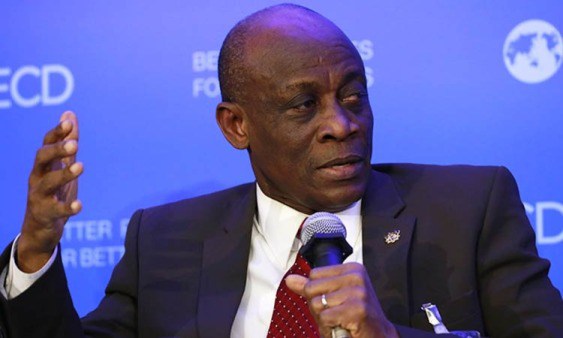The Minister for Finance under the erstwhile John Mahama administration, Seth Terkper, has reacted to an explanation given by the Central Bank Governor, Dr. Ernest Addison, as to government’s constant exclusion of exceptional costs in its fiscal deficit calculation.
The former Finance Minister has – since the incumbent government adopted what he describes as an ‘unconventional’ computation of the fiscal deficit – drawn attention to government’s reporting parallel macroeconomic data, particularly data on fiscal deficit, to Ghanaians and the International Monetary Fund (IMF). He has been very vocal about the incumbent government sticking to this non-conventional method of computing the nation’s fiscal deficit.
Speaking at the just-ended 97th Monetary Policy Committee (MPC) press briefing on Monday, November 23, Governor Addison – addressing a question on why government has since 2017 excluded exceptional costs in its fiscal deficit computation despite red flags raised about the computation method – noted the practice introduced two years ago under the International Monetary Fund (IMF) programme was to monitor the fiscal deficit performance of the budget.
“In 2018, when we were under an IMF programme, in order to be able to monitor the budget performance it was important that we computed the deficit to exclude the energy and financial sectors, as those were legacy problems that we had inherited.
“Now that we have finished the programme, given the developments of 2020 amid the pandemic, this is the time to take a relook at that area – the broader fiscal deficit, which includes the energy and financial sector issues.
“Over the medium-term, we need to redefine the broader fiscal deficit – which gives you a better sense of the burden on the budget,” the Governor explained.
However, in a rebuttal of the Governor’s explanation, Mr. Terkper accuses the government of excluding exceptional costs to show “impressive” fiscal deficit figures, and says the Governor’s explanation is untenable.
Mr. Terkper posits that the Governor’s excuse is flawed, given the fact that the IMF programme that began in 2014 under the NDC and was inherited by the NPP mandated that exceptional costs be computed as part of the nation’s fiscal deficit.
“The excuse that exceptional costs had to be separated from the other costs incurred by government because of the IMF programme is not tenable, because while under the IMF programme the most exceptional cost for the NDC – aside from the banks and energy arrears – was another legacy (emphasis) single spine wage overrun, and the IMF insisted that we quantify the cost, spread it over 3 years and add it to our fiscal framework; and compute it as part of our fiscal deficit,” he stated.
According to Mr. Terkper, Ghana’s fiscal framework – adopted since the 1980s – makes room for the computation of both exceptional costs and exceptional revenue.
He made reference to the fact that exceptional revenue from the HIPC programme Ghana underwent in the 2000s was added to government’s total revenue and included in the budget.
The incumbent government however includes exceptional revenue, including the legacy ESLA receipts, to its total revenue and puts it in the budget – but excludes exceptional ESLA-BASED costs.
“Exceptional revenue like HIPC and others were part of the budget, it has always been part of the budget. Under former President Rawlings, divestiture receipts coming in were recorded as part of revenue; so the fiscal framework takes care of exceptional costs and revenue,” he noted.
“But this government includes exceptional revenues from ESLA to its total revenue and puts it in the budget, but treats exceptional costs paid from ESLA differently,” he added.
Speaking further, the former Finance Minister averred that the much-talked-about exceptional costs from the financial and energy sectors were determined by the NDC government in 2016 through an audit assessment conducted by the BoG.
“ESLA was not an obligation under the IMF programme, it was an initiative by Mr. Mahama and the IMF was informed about it; and ESLA was simply to cater for the financial and energy sector costs because crude oil prices then had plunged, so ESLA was a way to clear debts in the two sectors,” Mr. Terkper intimated.
“We did the first restructuring of the sectors and the IMF was aware of it: we restructured VRA’s portion of the banking costs and used part of revenues from ESLA to pay for it; we put aside GH¢250million for banks as a cash injection, and also did restructuring worth GH¢2.2billion with 11-13 banks – and the IMF was aware of all of these things,” he emphasised.
According to Mr. Terkper, what he now finds surprising is not the fact that the incumbent government treated exceptional costs as footnotes, but that the IMF accepted exceptional costs being excluded from the fiscal framework as claimed by government.










